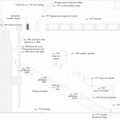
Reconstructing the ca. 1797 Stair
A similar method was used to determine where the stair stopped on the second floor. After the non-Madison plaster and framing was removed, the Restoration Team discovered that even though the stair hall had undergone major renovations in both ca. 1848 and ca. 1901, the framing for the Madison second floor landing survived intact. Amazingly, not only were the joists found, but the half-lap tenons for the stair carriages also remained in place. The tenons not only provided a key construction detail, they also provided the slope of the ¼ stair flight that ran from the second floor to the intermediate landing.

©The Montpelier Foundation
|
|
A masonry pocket that provided evidence for the height of the ca. 1797 stair's landing. |














